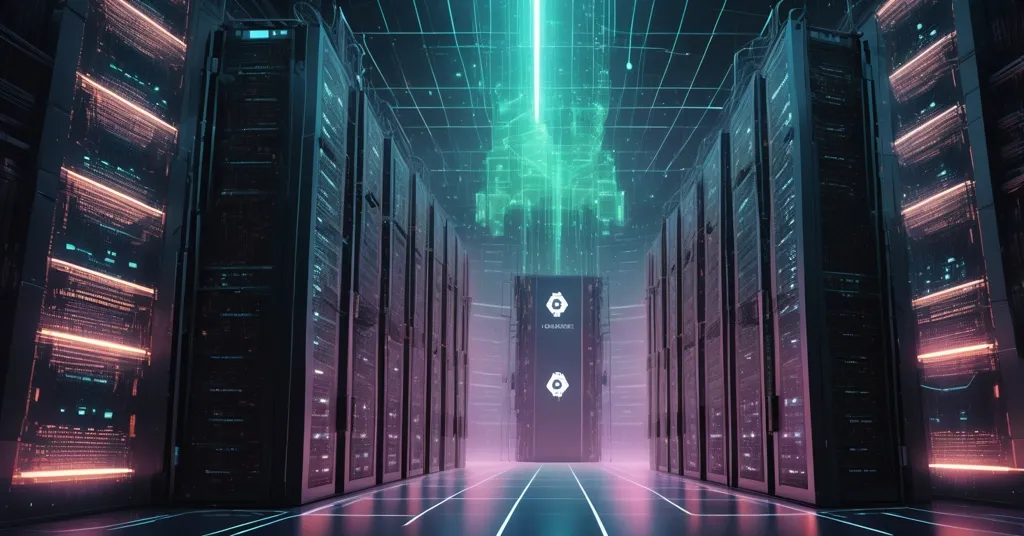Meta’s $27B AI Data Center with Blue Owl: Blockchain Implications Explored

Meta’s $27 Billion AI Gamble with Blue Owl: A Crypto Collision Course?
Meta has dropped a bombshell with a $27 billion joint venture alongside Blue Owl Capital to build the Hyperion data center in rural Louisiana. This isn’t just a tech project—it’s a monstrous push into AI infrastructure that could reshape the digital landscape, with sneaky implications for Bitcoin, blockchain, and decentralized tech. Let’s unpack this beast of a deal and see where it fits in our crypto-centric world.
- Meta and Blue Owl launch $27 billion Hyperion data center in Louisiana for AI training.
- Blue Owl owns 80% with $7 billion cash; Meta holds 20% and nets $3 billion payout.
- Hyperion targets 2+ gigawatts of power by 2030, but energy demands raise red flags.
- Could AI infrastructure trends impact Bitcoin and blockchain innovation?
Meta’s Mega AI Bet: The Hyperion Project
In Richland Parish, Louisiana, Meta is constructing what will be its largest data center yet—Hyperion. Set to be completed by 2030, this sprawling facility will cover an area the size of 1,700 football fields and deliver over 2 gigawatts of computing power. That’s a staggering amount of juice, specifically aimed at training large language models (LLMs)—the complex algorithms behind AI tools like chatbots and content generators. LLMs “learn” by processing massive datasets, requiring insane computational resources to predict and mimic human-like responses. For Meta, Hyperion is a cornerstone in its race against Alphabet, Amazon, and Microsoft to dominate the AI frontier, where the stakes couldn’t be higher.
But scale isn’t just about tech—it’s about ambition. Meta’s betting that AI will define the next decade, much like social media did the last. With Hyperion, they’re not just building servers; they’re building a foundation for applications that could infiltrate every corner of our digital lives. Sounds exciting, sure, but for crypto enthusiasts, it begs a question: what does this centralized tech push mean for the decentralized ethos we champion? To get a deeper look into this partnership, check out the details of Meta’s collaboration with Blue Owl for AI infrastructure.
Financial Wizardry: Blue Owl’s Role and Risk Mitigation
The numbers behind Hyperion are as eye-popping as the project itself. Blue Owl Capital, an investment heavyweight, takes an 80% stake with a $7 billion cash injection, while Meta holds 20% and oversees construction. As a cherry on top, Meta pockets a one-time $3 billion payout, a move finance chief Susan Li calls “a bold step forward.” This isn’t just cost-sharing—it’s a calculated play to dodge financial bullets. As Alvin Nguyen, a senior analyst at Forrester, notes, this setup “definitely helps them mitigate risks at the expense of their ownership stake… It also minimizes the debt they are taking on for equipment and property in the event there is a bursting of the AI bubble.”
Meta on the deal: “speed and flexibility” are essential to building Hyperion and fueling “long-term AI ambitions.”
Blue Owl Co-CEOs Doug Ostrover and Marc Lipschultz: Hyperion reflects “the scale and speed required to power the next generation of AI infrastructure.”
This kind of structured financing—where risks are offloaded through partnerships or special entities—is gaining traction. Think of it as creating a separate legal shell (a special purpose vehicle, in fancy terms) to isolate financial exposure, often tied to tangible assets like Nvidia GPUs. These are specialized chips built for high-speed processing, not just for AI but also for crypto mining rigs. For blockchain projects, which often face massive upfront costs for mining farms or staking networks, this model could be a game-changer. But let’s not get too starry-eyed—handing over control to investment firms like Blue Owl raises questions about who really pulls the strings in these tech empires.
Energy and Community Impact: The Hidden Costs
On the ground in Louisiana, Hyperion promises a boost with over 500 jobs created, a lifeline for Richland Parish’s economy. But there’s a darker side: power hunger. Local utility Entergy estimates the data center could consume nearly double the electricity of New Orleans on a peak day—enough to run roughly 1.5 million households for a year. That’s not just a big number; it’s a potential disaster for local grids and residents already grappling with utility bills. Hyperion’s appetite might make Bitcoin miners look like eco-warriors by comparison—ironic, isn’t it?
This energy dilemma mirrors the flak Bitcoin mining has faced for years. From Texas to Upstate New York, mining operations have been slammed for straining grids, with some communities pushing back hard. Hyperion’s scale amplifies these concerns, hinting at tougher regulations that could spill over to crypto. Could we see a future where AI data centers and Bitcoin mines are forced to adopt renewables or off-grid solutions? Some mining outfits already tap solar and hydro—maybe Big Tech should take notes. But until then, expect heated debates over who gets to hog the power, and at what cost to the little guy.
AI Frenzy: Big Tech’s $400 Billion Race
Meta isn’t alone in this AI arms race. Morgan Stanley pegs 2023 spending on AI infrastructure by major players—think Alphabet, Amazon, Microsoft, Meta, and upstarts like CoreWeave—at a jaw-dropping $400 billion. OpenAI has locked in deals worth over $1 trillion for 26 gigawatts of computing power, enough to electrify 20 million U.S. homes. Google’s dropping $15 billion on a data center in southern India, while OpenAI, Oracle, and SoftBank are behind the $500 billion Stargate venture, with a facility already running in Abilene, Texas. Even Elon Musk’s xAI raised $20 billion for its Colossus 2 data center in Memphis, leasing Nvidia GPUs through clever financing tricks.
This is Big Tech throwing cash at AI like it’s a bottomless Vegas slot machine. But whispers of an “AI bubble” are growing louder. If the tech fails to deliver—or if market winds shift—billions could vanish overnight. On the flip side, some argue AI’s transformative potential justifies the gamble, much like the internet boom of the ‘90s paid off despite early flops. For crypto, the takeaway isn’t just the scale—it’s the risk. If Big Tech stumbles, could blockchain projects tied to their infrastructure or partnerships take a hit? Or will decentralization prove its grit?
Crypto Crossovers: What This Means for Blockchain
Hyperion itself isn’t a blockchain project, but the parallels and potential crossovers are hard to ignore. AI and decentralized tech are colliding in fascinating ways. Imagine AI optimizing Ethereum gas fees through predictive algorithms or powering oracles like Chainlink to feed real-time data into smart contracts. Meta’s advancements could turbocharge tools for decentralized finance (DeFi), fraud detection on blockchain networks, or even Bitcoin market analysis—think smarter bots influencing crypto trades. The computing power of Hyperion might indirectly fuel such innovations, even if Meta’s focus remains squarely on centralized AI.
Then there’s funding. Structured investments, like xAI’s GPU leasing or Meta’s Blue Owl deal, could inspire crypto infrastructure projects. Mining farms, layer-2 scaling solutions, or staking hubs often bleed cash upfront—why not use similar risk-mitigation models? Geopolitically, spreading data centers to rural Louisiana or southern India echoes Bitcoin’s mining decentralization after China’s crackdown. Diversification strengthens resilience, a core tenet of BTC’s ethos. But as a Bitcoin maximalist, I can’t help but squint at Big Tech’s role. Meta and friends building centralized fortresses of compute power feels like the antithesis of permissionless freedom. If AI infrastructure sucks up resources and attention, will blockchain’s fight for financial sovereignty get sidelined?
Energy debates add another layer. If Hyperion’s power guzzling draws regulatory heat, Bitcoin mining could face collateral damage. We’ve seen Texas miners throttled by grid concerns—imagine that scrutiny on steroids. Yet, blockchain might dodge some fallout; unlike AI’s speculative sprawl, Bitcoin’s value lies in proven financial independence. Still, the overlap in challenges—energy, funding, scale—means crypto can’t ignore this AI tsunami. Hyperion’s success or stumble could set precedents for how decentralized tech evolves in a Big Tech-dominated world.
Key Questions and Takeaways
- How does Meta’s Blue Owl partnership impact AI and blockchain integration?
While focused on AI, Meta’s scaled infrastructure could speed up blockchain innovations like AI-driven DeFi protocols or market prediction tools for Bitcoin, blending centralized power with decentralized potential. - Could Hyperion’s energy demands influence Bitcoin mining regulations?
Hell yes—its massive power usage could fuel broader scrutiny on energy-hungry tech, dragging Bitcoin mining into stricter laws or forcing both sectors toward renewable solutions. - Are structured investments a blueprint for crypto infrastructure funding?
They might be; risk-sharing models like Meta’s could suit capital-heavy blockchain projects, from mining rigs to layer-2 networks, if adapted to decentralized priorities. - Is the AI boom a threat or ally to blockchain’s growth?
It’s both—AI can boost blockchain efficiency, but an “AI bubble” burst could divert funding or focus, stalling decentralized tech unless Bitcoin’s resilience shines through. - What risks does Big Tech’s AI frenzy pose to the crypto landscape?
Overinvestment in AI risks a market crash; if tech giants falter, blockchain projects leaning on their infrastructure or partnerships could suffer, testing decentralization’s true strength.
Meta’s $27 billion gamble with Blue Owl on Hyperion is a hell of a play in a game where AI and tech dominance are the prizes. But for us in the crypto trenches, it’s a double-edged sword—brimming with potential to enhance blockchain tools yet laden with risks of centralized overreach and resource wars. Energy battles, funding tricks, and geopolitical chess moves tie AI’s trajectory to ours more than we might like. So, as Big Tech charges ahead, one question looms for the decentralized faithful: will this infrastructure blitz strengthen the case for truly permissionless systems like Bitcoin, or drown us in a sea of corporate control? Time’s ticking, and the stakes couldn’t be higher.



